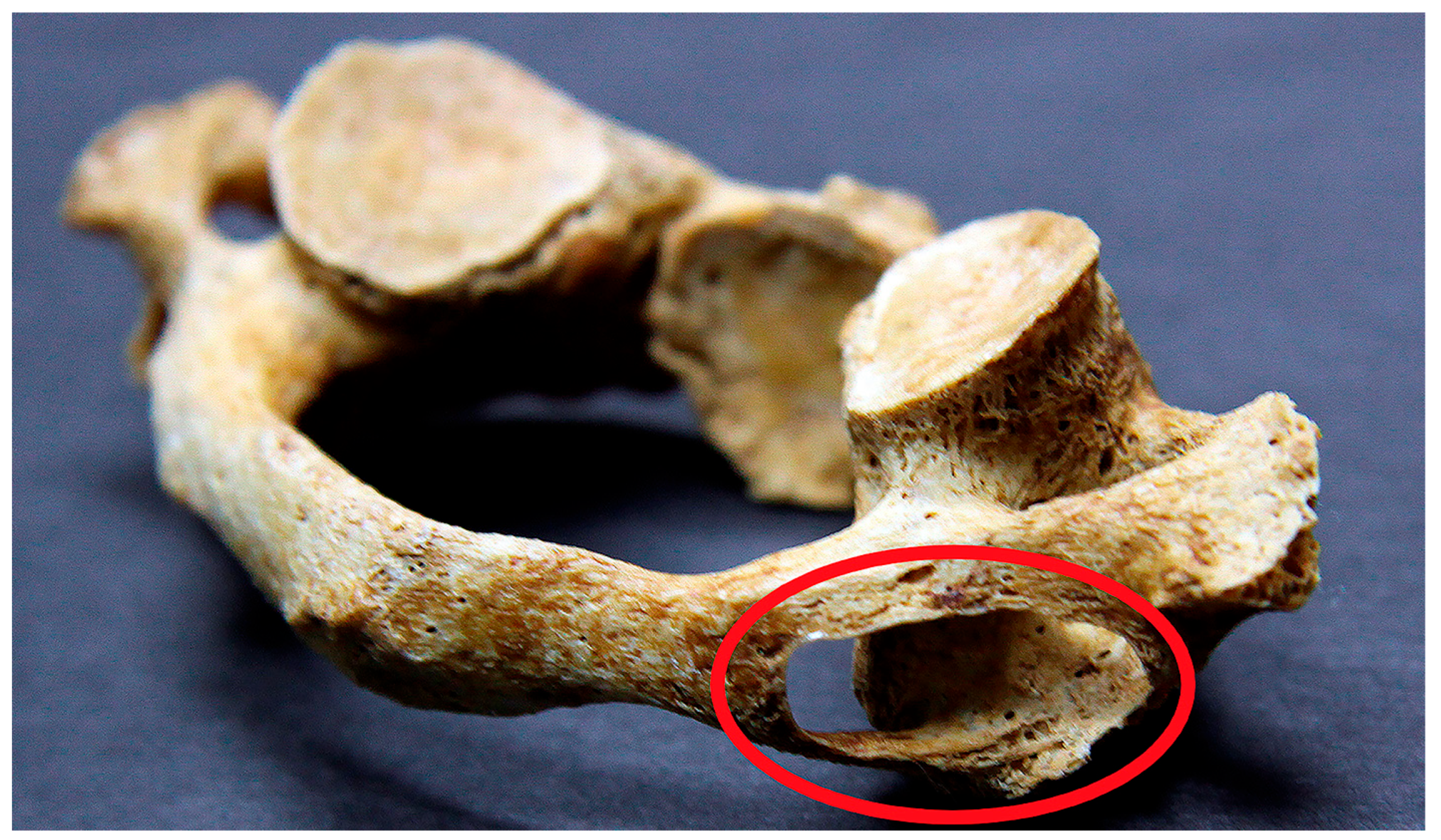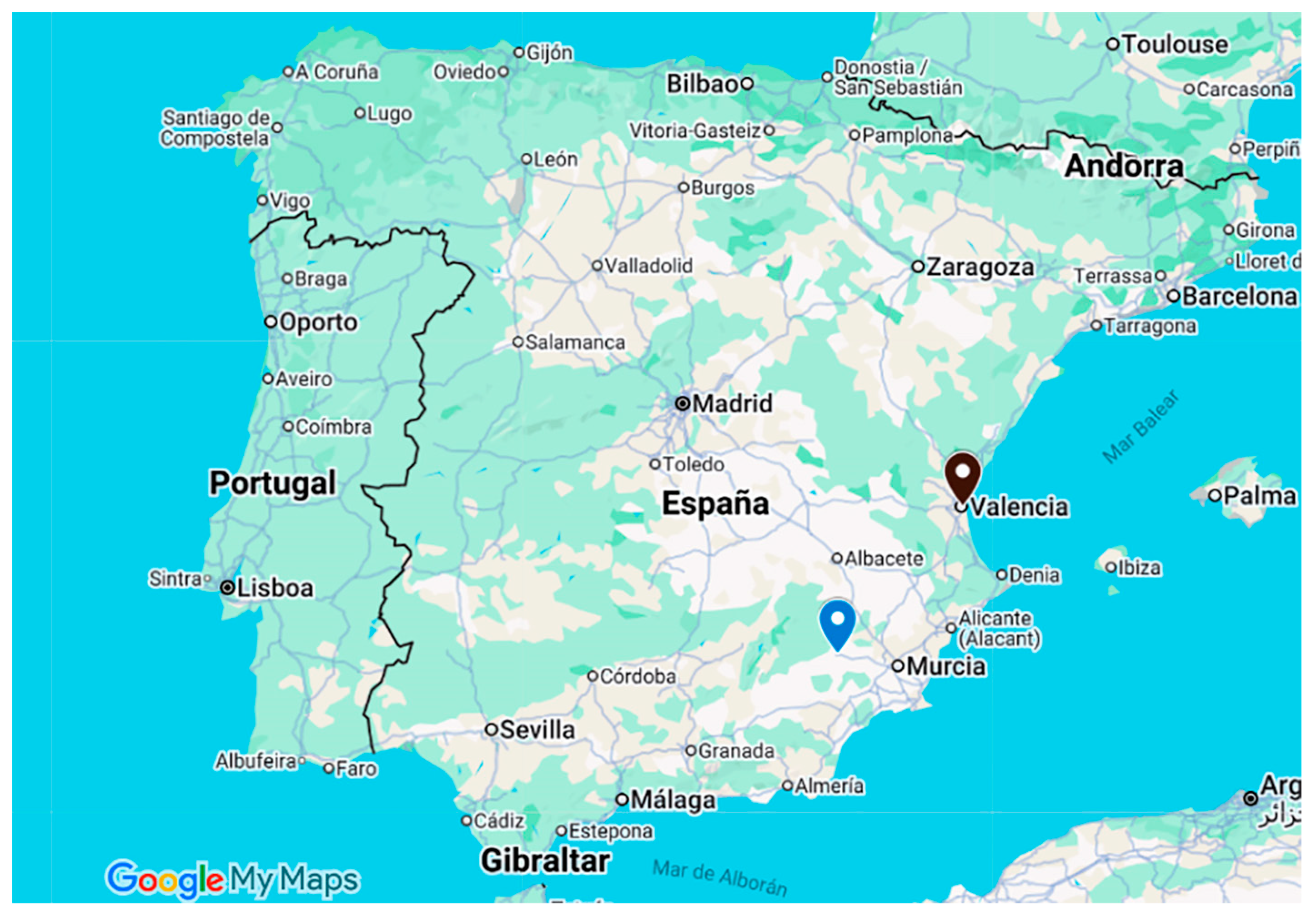Prevalence of the Arcuate Foramen: A Comparative Study Between a Chalcolithic and a Contemporary Iberian Peninsula Sample
Abstract
1. Introduction
2. Materials and Methods
3. Results
4. Discussion
5. Limitations
6. Conclusions
Author Contributions
Funding
Institutional Review Board Statement
Informed Consent Statement
Data Availability Statement
Conflicts of Interest
Abbreviations
| AF | Arcuate foramen |
| VA | Vertebral artery |
| CT | Computed tomography |
References
- Ahn, J.; Duran, M.; Syldort, S.; Rizvi, A.; D’Antoni, A.V.; Johal, J.; Iwanaga, J.; Oskouian, R.J.; Tubbs, R.S. Arcuate Foramen: Anatomy, Embryology, Nomenclature, Pathology, and Surgical Considerations. World Neurosurg. 2018, 118, 197–202. [Google Scholar] [CrossRef]
- Cirpan, S.; Yonguc, G.N.; Edizer, M.; Mas NGi Magden, A.O. Foramen arcuale: A rare morphological variation located in atlas vertebrae. Surg. Radiol. Anat. 2017, 39, 877–884. [Google Scholar] [CrossRef] [PubMed]
- Rios, L.; Mata-Escolano, F.; Blanco-Perez, E.; Llido, S.; Bastir, M.; Sanchis-Gimeno, J.A. Acute headache at-tributed to whiplash in arcuate foramen and non-arcuate foramen subjects. Eur. Spine J. 2017, 26, 1262–1265. [Google Scholar] [CrossRef]
- Tubbs, R.S.; Johnson, P.C.; Shoja, M.M.; Loukas, M.; Oakes, W.J. Foramen arcuale: Anatomical study and review of the literature. J. Neurosurg. Spine 2007, 6, 31–34. [Google Scholar] [CrossRef]
- Elliott, R.E.; Tanweer, O. The Prevalence of the Ponticulus Posticus (Arcuate Foramen) and Its Importance in the Goel-Harms Procedure: Meta-Analysis and Review of the Literature. World Neurosurg. 2014, 82, E335–E343. [Google Scholar] [CrossRef]
- Krishnamurthy, A.; Nayak, S.R.; Khan, S.; Prabhu, L.V.; Ramanathan, L.A.; Kumar, C.G.; Sinha, A.P. Arcuate foramen of atlas: Incidence, phylogenetic and clinical significance. Rom. J. Morphol. Embryol. 2007, 48, 263–266. [Google Scholar]
- Simsek, S.; Yigitkanli, K.; Comert, A.; Acar, H.I.; Seckin, H.; Er, U.; Belen, D.; Tekdemir, I.; Elhan, A. Posterior osseous bridging of C1. J. Clin. Neurosci. 2008, 15, 686–688. [Google Scholar] [CrossRef] [PubMed]
- Huang, D.G.; Hao, D.J.; Fang, X.Y.; Zhang, X.L.; He, B.R.; Liu, T.J. Ponticulus posticus. Spine J. 2015, 15, E17–E19. [Google Scholar] [CrossRef] [PubMed]
- Nedelcu, A.H.; Hutanu, A.; Nedelcu, I.; Vicoleanu, S.P.; Statescu, G.; Gavril, L.; Haliciu, A.M.; Ursaru, M.; Tarniceriu, C.C. The Prevalence and Morphology-Wise Demographic Distribution of Ponticulus Posticus on CT Scans-A Retrospective Observational Study. Medicina 2023, 59, 650. [Google Scholar] [CrossRef]
- Wysocki, J.; Bubrowski, M.; Reymond, J.; Kwiatkowski, J. Anatomical variants of the cervical vertebrae and the first thoracic vertebra in man. Folia Morphol. 2003, 62, 357–363. [Google Scholar]
- Monika, L.; Anupama, M.; Sanjay, P.; Jagdev, S.K. An Anatomical Study of the Morphometric Differences between Complete Arcuate Foramina and Ipsilateral Foramina Transversaria in Human Atlas Vertebrae Could These Be Responsible for Vaso-occlusive Symptoms? Nat. J. Clin. Anat. 2019, 8, 106–111. [Google Scholar]
- Pinhasi, R.; Thomas, M.G.; Hofreiter, M.; Currat, M.; Burger, J. The genetic history of Europeans. Trends Genet. 2012, 28, 496–505. [Google Scholar] [CrossRef]
- Kibaroglu, M.; Schuhmacher, T.X.; Mederos, A.; Falkenstein, F.; Vargas, J.M.; Mertz-Kraus, R.; Hacıosmanoğlu, S. Investigating the Late Chalcolithic pottery production and consumption at Valencina de la Concepciton (Seville, SW-Spain): An archaeometric analysis using petrographic and LA-ICP-MS techniques. J. Archaeol. Sci. Rep. 2024, 53, 104299. [Google Scholar]
- Díaz-Navarro, S.; García-González, R.; Cirotto, N.; Haber-Uriarte, M. New insight into prehistoric craft specialisation. Tooth-tool use in the Chalcolithic burial site of Camino del Molino, Murcia, SE Spain. J. Archaeol. Sci. Rep. 2023, 50, 104066. [Google Scholar] [CrossRef]
- Díaz-Navarro, S.; Haber Uriarte, M.; Tejedor-Rodríguez, C.; Lomba Maurandi, J. Emphasising the community: Demographic composition of an exceptional tomb—The Chalcolithic burial site of Camino del Molino, Caravaca de la Cruz, Murcia. Archaeol. Anthropol. Sci. 2023, 15, 140. [Google Scholar]
- Loth, S.R.; Iscan, M.Y. Morphological assessment of age in the adult: The thoracic region. In Age Markers in the Human Skeleton; Iscan, M.Y., Ed.; Charles C Thomas: Springfield, IL, USA, 1989; pp. 105–135. [Google Scholar]
- Reverte-Coma, J.M. Antropología Forense [Forensic Anthropology]; Ministerio de Justicia, Secretaria General Técnica, Centro de Publicaciones: Madrid, Spain, 1991. [Google Scholar]
- Burns, K.R. Manual de Antropología Forense [Manual of Forensic Anthropology]; Edicions Bellaterra SL: Barcelona, Spain, 2008. [Google Scholar]
- Macri, M.; Perrella, G.; Varvara, G.; Murmura, G.; Traini, T.; Rendina, F.; Festa, F. Assessments of Prevalence of Ponticulus Posticus, Atlas Posterior Arch Deficiency, Sella Turcica Bridging, Maxillary Canine Impaction, and Associations Among Them in 500 CBCTs of Italian Orthodontic Patients. Front. Dent. Med. 2021, 2, 708169. [Google Scholar] [CrossRef]
- Geist, J.; Geist, S.M.R.Y.; Lin, L.M. A cone beam CT investigation of ponticulus posticus and lateralis in children and adolescents. Dentomaxillofacial Radiol. 2014, 43, 20130451. [Google Scholar] [CrossRef]
- Schilling, J.; Schilling, A.; Galdames, I.S. Ponticulus posticus on the Posterior Arch of Atlas, Prevalence Analysis in Asymptomatic Patients. Int. J. Morphol. 2010, 28, 317–322. [Google Scholar] [CrossRef]
- Erdem, S.; Gündüz, K.; Kasap, P. Evaluation of the Ponticulus Posticus with Cone-beam Computed To-mography in a Turkish Population. J. Anat. Soc. Ind. 2023, 72, 140–144. [Google Scholar]
- Karapetian, M.K. Discrete morphological variants of human cervical vertebrae: Exploring pattern of distribution and biological significance. HOMO 2017, 68, 176–198. [Google Scholar] [CrossRef]
- Saunders, S.R.; Popovich, F. A family study of two skeletal variants: Atlas bridging and clinoid bridging. Am. J. Phys. Anthropol. 1978, 49, 193–203. [Google Scholar] [CrossRef]
- Cakmak, O.; Gurdal, E.; Ekinci, G.; Yildiz, E.; Cavdar, S. Arcuate foramen and its clinical significance. Saudi Med. J. 2005, 26, 1409–1413. [Google Scholar]
- Chitroda, P.K.; Katti, G.; Baba, I.A.; Najmudin, M.; Ghali, S.R.; Kalmath, B.; G, V. Ponticulus Posticus on the Posterior Arch of Atlas, Prevalence Analysis in Symptomatic and Asymptomatic Patients of Gulbarga Population. J. Clin. Diagn. Res. 2013, 7, 3044–3047. [Google Scholar] [CrossRef]
- Koutsouraki, E.; Avdelidi, E.; Michmizos, D.; Kapsal, S.E.; Costa, V.; Baloyannis, S. Kimmerle’s Anomaly as a Possible Causative Factor of Chronic Tension-Type Headaches and Neurosensory Hearing Loss: Case Re-port and Literature Review. Int. J. Neurosci. 2010, 120, 236–239. [Google Scholar] [CrossRef]
- Pekala, P.A.; Henry, B.M.; Pekala, J.R.; Hsieh, W.C.; Vikse, J.; Sanna, B.; Walocha, J.A.; Tubbs, R.S.; Tomaszewski, K.A. Prevalence of foramen arcuale and its clinical significance: A meta-analysis of 55,985 subjects. J. Neurosurg. Spine 2017, 27, 276–290. [Google Scholar] [CrossRef]
- Pekala, P.A.; Henry, B.M.; Phan, K.; Pekala, J.R.; Taterra, D.; Walocha, J.A.; Tubbs, R.S.; Tomaszewski, K.A. Presence of a foramen arcuale as a possible cause for headaches and migraine: Systematic review and meta-analysis. J. Clin. Neurosci. 2018, 54, 113–118. [Google Scholar] [CrossRef]
- Natsis, K.; Piperaki, E.T.; Fratzoglou, M.; Lazaridis, N.; Tsitsopoulos, P.P.; Samolis, A.; Kostares, M.; Piagkou, M. Atlas posterior arch and vertebral artery’s groove variants: A classification, morphometric study, clinical and surgical implications. Surg. Radiol. Anat. 2019, 41, 985–1001. [Google Scholar] [CrossRef]
- Paschopoulos, I.; Piagkou, M.; Triantafyllou, G.; Papadopoulos-Manolarakis, P.; Duparc, F.; Demetriou, F.; Tsakotos, G.; Tudose, R.C.; Rusu, M.C.; Toader, O.D. The Potential Morphological Stenosis Pattern of the Arcuate Foramen. Diagnostics 2025, 15, 1203. [Google Scholar] [CrossRef]


| Chalcolithic Sample (n = 34) | Present-Day Living Subjects (n = 120) | ||||
|---|---|---|---|---|---|
| Total | Unilateral | Bilateral | Total | Unilateral | Bilateral |
| 4 (11.8%) | 1 (2.9%) | 3 (8.8%) | 14 (11.6%) | 7 (5.8%) | 7 (5.8%) |
| Chalcolithic Males (n = 11) | Present-Day Living Males (n = 36) | ||||
|---|---|---|---|---|---|
| Total | Unilateral | Bilateral | Total | Unilateral | Bilateral |
| 2 (18.2%) | 1 (9.1%) | 1 (9.1%) | 5 (13.9%) | 2 (5.6%) | 3 (8.3%) |
| Chalcolithic Females (n = 23) | Present-Day Living Females (n = 84) | ||||
|---|---|---|---|---|---|
| Total | Unilateral | Bilateral | Total | Unilateral | Bilateral |
| 2 (8.7%) | 0 (0.0%) | 2 (8.7%) | 9 (10.7%) | 5 (5.9%) | 4 (4.8%) |
Disclaimer/Publisher’s Note: The statements, opinions and data contained in all publications are solely those of the individual author(s) and contributor(s) and not of MDPI and/or the editor(s). MDPI and/or the editor(s) disclaim responsibility for any injury to people or property resulting from any ideas, methods, instructions or products referred to in the content. |
© 2025 by the authors. Licensee MDPI, Basel, Switzerland. This article is an open access article distributed under the terms and conditions of the Creative Commons Attribution (CC BY) license (https://creativecommons.org/licenses/by/4.0/).
Share and Cite
Tuncel-Cini, N.; Llido, S.; Lomba-Maurandi, J.; Haber-Uriarte, M.; Mata-Escolano, F.; Blanco-Perez, E.; Orellana-Donoso, M.; Valenzuela-Fuenzalida, J.J.; Granite, G.; Leon-Rojas, J.E.; et al. Prevalence of the Arcuate Foramen: A Comparative Study Between a Chalcolithic and a Contemporary Iberian Peninsula Sample. Heritage 2025, 8, 452. https://doi.org/10.3390/heritage8110452
Tuncel-Cini N, Llido S, Lomba-Maurandi J, Haber-Uriarte M, Mata-Escolano F, Blanco-Perez E, Orellana-Donoso M, Valenzuela-Fuenzalida JJ, Granite G, Leon-Rojas JE, et al. Prevalence of the Arcuate Foramen: A Comparative Study Between a Chalcolithic and a Contemporary Iberian Peninsula Sample. Heritage. 2025; 8(11):452. https://doi.org/10.3390/heritage8110452
Chicago/Turabian StyleTuncel-Cini, Nilgun, Susanna Llido, Joaquin Lomba-Maurandi, Maria Haber-Uriarte, Federico Mata-Escolano, Esther Blanco-Perez, Mathias Orellana-Donoso, Juan José Valenzuela-Fuenzalida, Guinevere Granite, José E. Leon-Rojas, and et al. 2025. "Prevalence of the Arcuate Foramen: A Comparative Study Between a Chalcolithic and a Contemporary Iberian Peninsula Sample" Heritage 8, no. 11: 452. https://doi.org/10.3390/heritage8110452
APA StyleTuncel-Cini, N., Llido, S., Lomba-Maurandi, J., Haber-Uriarte, M., Mata-Escolano, F., Blanco-Perez, E., Orellana-Donoso, M., Valenzuela-Fuenzalida, J. J., Granite, G., Leon-Rojas, J. E., & Sanchis-Gimeno, J. (2025). Prevalence of the Arcuate Foramen: A Comparative Study Between a Chalcolithic and a Contemporary Iberian Peninsula Sample. Heritage, 8(11), 452. https://doi.org/10.3390/heritage8110452







